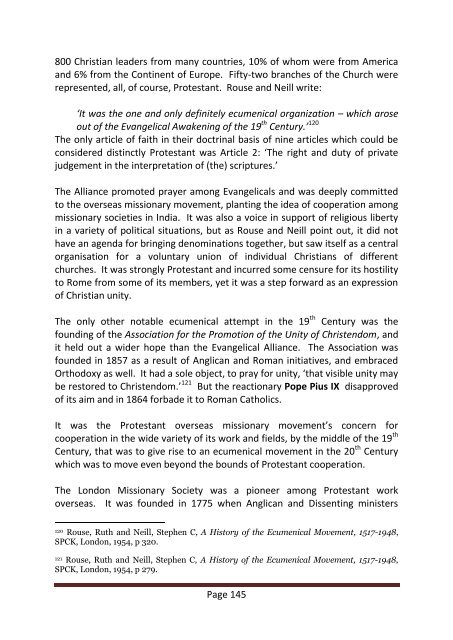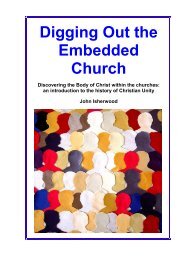Christian Unity (the book) - The Maranatha Community
Christian Unity (the book) - The Maranatha Community
Christian Unity (the book) - The Maranatha Community
Create successful ePaper yourself
Turn your PDF publications into a flip-book with our unique Google optimized e-Paper software.
800 <strong>Christian</strong> leaders from many countries, 10% of whom were from Americaand 6% from <strong>the</strong> Continent of Europe. Fifty-two branches of <strong>the</strong> Church wererepresented, all, of course, Protestant. Rouse and Neill write:‘It was <strong>the</strong> one and only definitely ecumenical organization – which aroseout of <strong>the</strong> Evangelical Awakening of <strong>the</strong> 19 th Century.’ 120<strong>The</strong> only article of faith in <strong>the</strong>ir doctrinal basis of nine articles which could beconsidered distinctly Protestant was Article 2: ‘<strong>The</strong> right and duty of privatejudgement in <strong>the</strong> interpretation of (<strong>the</strong>) scriptures.’<strong>The</strong> Alliance promoted prayer among Evangelicals and was deeply committedto <strong>the</strong> overseas missionary movement, planting <strong>the</strong> idea of cooperation amongmissionary societies in India. It was also a voice in support of religious libertyin a variety of political situations, but as Rouse and Neill point out, it did nothave an agenda for bringing denominations toge<strong>the</strong>r, but saw itself as a centralorganisation for a voluntary union of individual <strong>Christian</strong>s of differentchurches. It was strongly Protestant and incurred some censure for its hostilityto Rome from some of its members, yet it was a step forward as an expressionof <strong>Christian</strong> unity.<strong>The</strong> only o<strong>the</strong>r notable ecumenical attempt in <strong>the</strong> 19 th Century was <strong>the</strong>founding of <strong>the</strong> Association for <strong>the</strong> Promotion of <strong>the</strong> <strong>Unity</strong> of Christendom, andit held out a wider hope than <strong>the</strong> Evangelical Alliance. <strong>The</strong> Association wasfounded in 1857 as a result of Anglican and Roman initiatives, and embracedOrthodoxy as well. It had a sole object, to pray for unity, ‘that visible unity maybe restored to Christendom.’ 121 But <strong>the</strong> reactionary Pope Pius IX disapprovedof its aim and in 1864 forbade it to Roman Catholics.It was <strong>the</strong> Protestant overseas missionary movement’s concern forcooperation in <strong>the</strong> wide variety of its work and fields, by <strong>the</strong> middle of <strong>the</strong> 19 thCentury, that was to give rise to an ecumenical movement in <strong>the</strong> 20 th Centurywhich was to move even beyond <strong>the</strong> bounds of Protestant cooperation.<strong>The</strong> London Missionary Society was a pioneer among Protestant workoverseas. It was founded in 1775 when Anglican and Dissenting ministers120Rouse, Ruth and Neill, Stephen C, A History of <strong>the</strong> Ecumenical Movement, 1517-1948,SPCK, London, 1954, p 320.121Rouse, Ruth and Neill, Stephen C, A History of <strong>the</strong> Ecumenical Movement, 1517-1948,SPCK, London, 1954, p 279.Page 145








